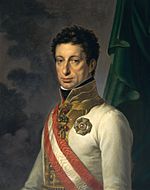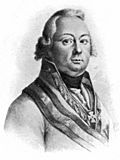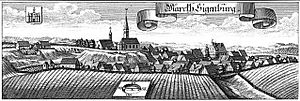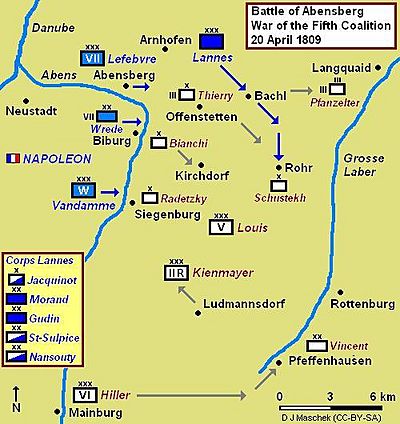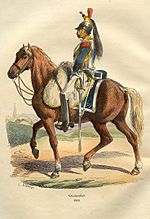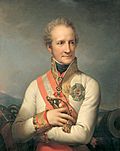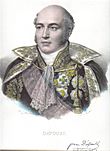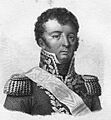Battle of Abensberg facts for kids
Quick facts for kids Battle of Abensberg |
|||||||
|---|---|---|---|---|---|---|---|
| Part of the War of the Fifth Coalition | |||||||
 Napoleon addressing Bavarian and Württemberg troops at Abensberg, by Jean-Baptiste Debret (1810) |
|||||||
|
|||||||
| Belligerents | |||||||
| Commanders and leaders | |||||||
| Strength | |||||||
| 55,000 | 42,000 | ||||||
| Casualties and losses | |||||||
| 1,000 | 7,200, 12 guns | ||||||
The Battle of Abensberg happened on April 20, 1809. It was a major fight during the War of the Fifth Coalition. This battle involved French and German forces led by Emperor Napoleon I of France. They fought against Austrian troops commanded by Archduke Louis of Austria and later Johann von Hiller. The battle took place near Abensberg in Bavaria, Germany. It was a big victory for Napoleon's forces.
The fighting spread across several areas, including Offenstetten, Biburg-Siegenburg, Rohr in Niederbayern, and Rottenburg an der Laaber. On the same day, the French soldiers defending Regensburg had to surrender. This battle was a key moment in Napoleon's plan to break through the Austrian defenses.
Contents
Understanding the Battle of Abensberg
Why the Battle Happened
The war began when Austria, led by Archduke Charles of Austria, invaded Bavaria on April 10, 1809. This move put Napoleon's French army and their German allies in a tough spot. Napoleon's second-in-command, Marshal Louis Alexandre Berthier, had spread out the French army too much. This made it hard for them to gather quickly.
On April 16, the main Austrian army crossed the Isar River near Landshut. Napoleon arrived from Paris the next day. He quickly tried to take control of the situation. He ordered his troops to come together. Marshal André Masséna and General Nicolas Oudinot were sent to Landshut. Their goal was to cut off the Austrian supply lines.
Meanwhile, Marshal François Joseph Lefebvre's Bavarian troops were to hold the center at Abensberg. Marshal Louis-Nicolas Davout's troops on the left were to move west to avoid being trapped.
The Day Before: Teugen-Hausen
On April 19, Archduke Charles saw a chance to defeat Davout's army. He sent about 65,000 Austrian soldiers to attack Davout. However, the Austrians on their right flank found no enemy troops. In the center, French cavalry and infantry, led by General Louis-Pierre Montbrun, bravely held off a much larger Austrian force.
On the left, a fierce battle broke out at Battle of Teugen-Hausen. Austrian troops attacked General Louis Vincent Le Blond de Saint-Hilaire's division. Both sides sent in more soldiers. By late afternoon, Davout's forces pushed the Austrians back a short distance. That night, the Austrians pulled back slightly to be closer to their main army.
During this time, a smaller Austrian force, led by General Ludwig Thierry, fought with Bavarian troops near Arnhofen. They were forced to retreat to Offenstetten.
Austrian Army Positions
On April 20, Archduke Charles's main army was near Dünzling and Eckmühl. Another Austrian force, led by Johann Kollowrat, had been attacking Regensburg from the north. The French soldiers defending Regensburg were running low on ammunition.
Archduke Louis's Austrian troops were spread out behind the Abens River. They faced west. They had about 42,000 soldiers in total. Many of their units had been sent to other places. General Johann von Hiller arrived later to take command of these forces.
French Army Positions
Napoleon quickly put Marshal Jean Lannes in charge of a special group of soldiers. This group included troops from Davout's army and cavalry. General Dominique Vandamme was to attack Siegenburg with his Württemberg soldiers. Other Bavarian divisions would connect Lannes and Vandamme.
Napoleon believed the main Austrian army was directly in front of him. So, he ordered his forces to push southeast towards Landshut. Lannes's job was to attack the Austrian right flank by moving south towards Rohr. Napoleon also ordered Masséna's army to capture Landshut. This would cut off the Austrian supply lines.
The Battle Unfolds
Fighting at Abensberg
Archduke Charles sent orders to his brother, Archduke Louis, at 7:30 AM on April 20. He told Louis to fall back to Rottenburg. Charles made a mistake by sending these orders late. He also didn't tell Louis that other Austrian troops had already moved east. This left Louis's right side open to attack.
Small Austrian groups were positioned at Bachl and Offenstetten. Marshal Lannes's advance troops reached Bachl in the late morning. They pushed back the small Austrian force there. Bavarian and French divisions then attacked Offenstetten. They defeated General Thierry's Austrian brigade, forcing them to retreat to Rohr.
Another report says that the Austrian commander at Bachl had already pulled back his troops. This left the road open. General Thierry's soldiers found that French cavalry already occupied Bachl. Thierry's men were chased into the woods by French horsemen. They then tried to reach Rohr by going cross-country.
Lannes's soldiers arrived at Rohr before Thierry's tired infantry. The Austrian commander, Schustekh, was surprised. He bravely sent his cavalry to attack the French advance guard. However, the French cavalry, including cuirassiers (heavy cavalry), were too strong. They broke through the Austrian cavalry and infantry.
More than 3,000 Austrian soldiers were captured, including General Thierry. Four cannons were also lost.
Meanwhile, General Hiller arrived at Siegenburg around midday. He took command of the three Austrian corps on the left side. He sent troops towards Rottenburg to help. Archduke Louis had placed troops at Siegenburg and Biburg. Bavarian troops, led by Karl Philipp von Wrede, tried to cross the Abens River at Siegenburg but were stopped.
Wrede then moved north to Biburg and managed to cross the river. General Vandamme's Württemberg troops replaced Wrede at Siegenburg. Vandamme also moved north and crossed the river at Abensberg. He then moved south to Kirchdorf. Here, the Bavarians and Württembergers fought with Austrian forces. The Austrians were forced to retreat southeast.
The Bavarians continued to push the Austrians. They captured many prisoners. The Austrians burned a bridge to slow them down. Even so, the Bavarians kept up the pressure, crossing the Große Laber River late at night. The Austrians retreated to a hill and fought the Bavarians into the early morning.
At Rottenburg, Austrian troops found the road blocked by their own army's supply wagons. Austrian cavalry charged the French to give their infantry time to get into position. General Hiller ordered a counterattack. Austrian soldiers fought fiercely with French and Bavarian infantry. Despite their efforts, the Austrians were pushed back by larger numbers. They lost about 600 men, but they finally stopped the enemy's advance.
The Fall of Regensburg
On April 20, Austrian forces continued to attack the French soldiers defending Regensburg. The French ran out of ammunition. Their commander, Colonel Louis Coutard, asked for a 24-hour break, promising to surrender if no help arrived. The Austrian commander agreed.
However, another Austrian force, led by Prince Johann I Joseph, Prince of Liechtenstein, soon arrived. Liechtenstein said the truce didn't apply to him and demanded an immediate surrender. Colonel Coutard had no choice but to give up at 5:00 PM. The French had tried to destroy the strong bridge at Regensburg, but they couldn't. This intact bridge later helped Archduke Charles's army escape.
In two days of fighting at Regensburg, the French lost about 200 soldiers killed or wounded, and nearly 2,000 were captured. Austrian losses were much lower.
What Happened Next
After the battle, the French and their German allies had about 1,100 casualties. The Austrians suffered much heavier losses, with about 7,200 soldiers killed, wounded, or captured. They also lost 12 cannons.
That evening, General Hiller realized how badly his forces had been defeated. He decided to move his three corps behind the Isar River at Landshut. This decision meant that Hiller's army would now operate separately from Archduke Charles's main army. They would not reunite until May 15, north of Vienna.
While Napoleon was winning against the Austrian left wing, Archduke Charles remained strangely inactive. For several hours, he failed to give any orders. It's thought he might have been focused on capturing Regensburg, or perhaps he was unwell. Because of this, Davout's remaining French divisions were not attacked by the main Austrian army on April 20.
Even though Napoleon had fewer total soldiers, his forces managed to split the spread-out Austrian army into two parts. Charles's five corps were to the north, while Hiller's three corps retreated to Landshut. Both Austrian forces then had to fight more major battles. Hiller fought the Battle of Landshut on April 21. Charles fought the Battle of Eckmühl on April 22.
Images for kids


